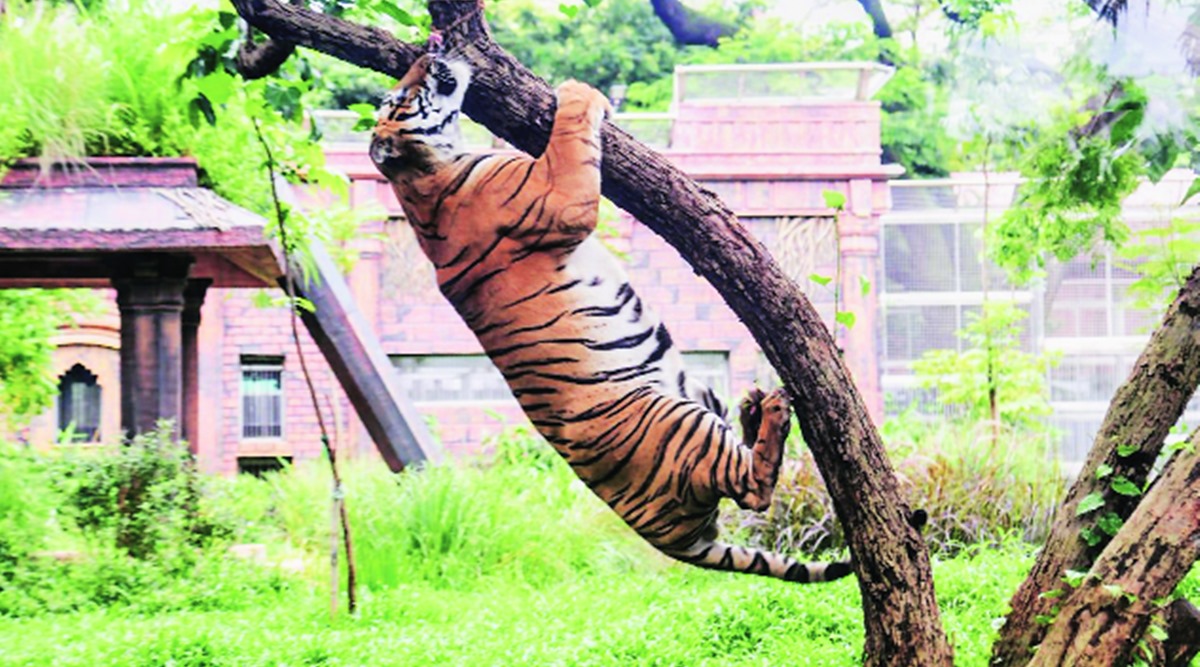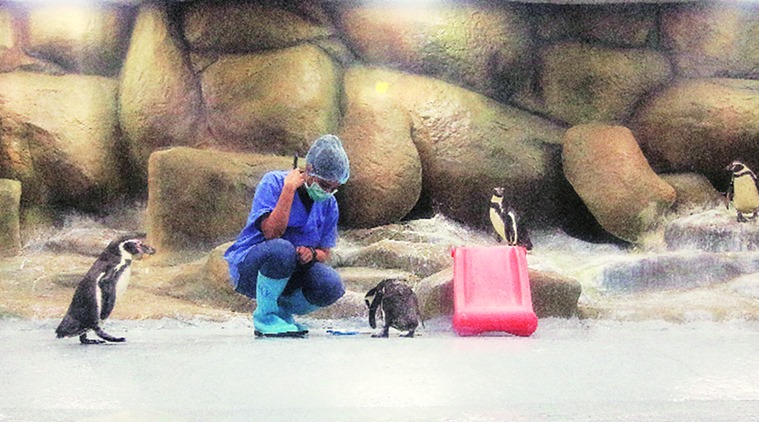 Chicken pieces are hung on trees to give tigers an experience of hunting for food (Photo courtesy: BMC)
Chicken pieces are hung on trees to give tigers an experience of hunting for food (Photo courtesy: BMC)THE CORONAVIRUS pandemic has left Donald, Daisy, Popeye, Olive, Flipper, Bubble and Mr Molt without an audience for the past few months. But looking at them playfully walk and swim around their enclosure, it seems that the penguins, the seven most celebrated birds at Byculla zoo, don’t seem to be too upset with their newfound privacy.
After having spent over two years under the constant human gaze, zookeepers here say that the penguins seemed more relaxed, responsive and active in the past five months.
And it is not just the birds. Most animals at the zoo have become less shy and stress-free since the zoo closed for the public on March 15 due to the coronavirus pandemic. Prior to the lockdown, the zoo on an average saw 15,000 visitors on weekdays. Their numbers jumped over 30,000 on weekends, with the penguins remaining the cynosure of all attraction.
 At the Byculla zoo. (File)
At the Byculla zoo. (File)
Also known as the Veermata Jijabai Bhosale Udyan, the zoological garden is spread over 50 acres and houses over 300 animals, birds and reptiles.
According to zoo staffers, the previously timid deer herd are now spotted venturing out in their exhibit without any coaxing from their keepers. Dr Komal Raul, veterinary, Byculla zoo, said, “Deer usually are timid. Even with the coaxing from their keepers, they hardly move. But in these last few months, they have become noticeably active.”
While the birds, deer herd and penguins are enjoying their solitary environment, the more social animals, including monkeys, and even the usually known solitary animals, like tigers and leopards, in the over 150-year-old zoo are missing human interaction. Caretakers have been implementing various innovative ideas to help these animals enjoy their time at the enclosure: chicken pieces are hung on trees to give tigers an experience of hunting for food, while sloth bears are tasked with fetching coconuts.
“We are organising enrichment programmes for the animals. They are given small tasks each week to improve their natural instincts,” Raul said.
The leopards, Drogone and Pinto, the newest inhabitants of the zoo, however, are mostly seen walking near the glass end of their exhibit. “The animals are more active than usual but are bored. They are curious and are spending more time near the glass end of the exhibit, seeking reaction when they notice human presence, either by walking parallelly to the person or just roaring,” Raul added. The big cats have also shown their fondness for baths and water activities, which is not a natural behaviour.
The Royal Bengal tiger pair has also shown signs of missing human presence and interaction. Karishma, a five-year-old tigress, didn’t leave its 4,000-sq metre exhibit for a week since the pair was released in the newly built enclosure. “She used to enter the shelter in the evening for food and then return to the exhibit. No amount of coaxing worked. After swimming, jumping, roaming and running from one end to another for about one week, she entered the night shelter,” Raul added.
With visitors unlikely to return soon, the zoo authority is now mulling over to create an online presence. “We will soon float a tender for a social media expert or company, which will develop the zoo’s presence on YouTube, Facebook, Twitter. People can take a glimpse of our animals through such programmes,” Dr Sanjay Tripathi, zoo director, said.
Once they are reopened, the process to allow visitors, zoo staffers said, will be steady but not immediate. “Crowd management will be the key when the zoo reopens. Footfall per day will have to be restricted. The sudden presence of visitors will not be good for the animals,” Raul said.